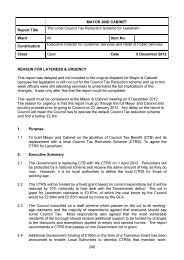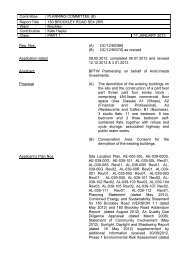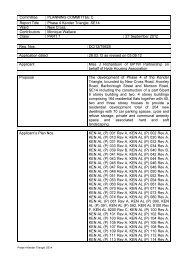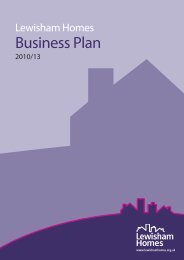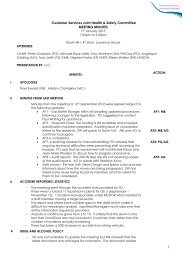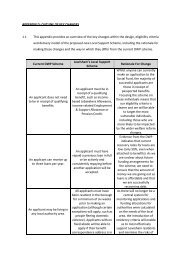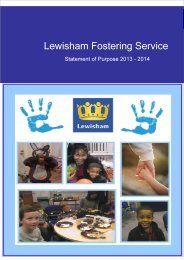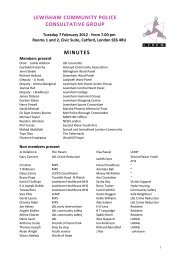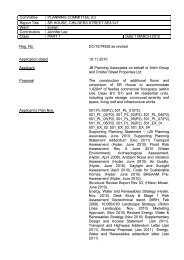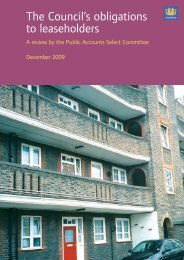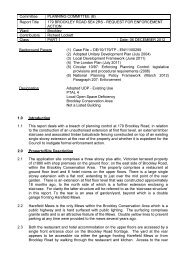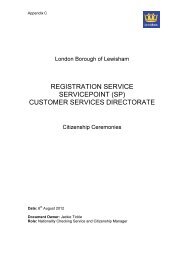Teenage pregnancy PDF 101 KB - Council meetings
Teenage pregnancy PDF 101 KB - Council meetings
Teenage pregnancy PDF 101 KB - Council meetings
Create successful ePaper yourself
Turn your PDF publications into a flip-book with our unique Google optimized e-Paper software.
CHILDREN AND YOUNG PEOPLE’S SELECT COMMITTEE<br />
Report Title<br />
Update on the <strong>Teenage</strong> Pregnancy Programme<br />
Key Decision No Item No.<br />
Ward<br />
Contributors<br />
All Wards<br />
Executive Director of Children and Young People<br />
Head of Commissioning, Early Intervention and Targeted Support<br />
Consultant in Public Health (Sexual Health and Mental Health)<br />
Service Manager Youth Support Services<br />
Class Date: 5 th March 2013<br />
1. Purpose of report<br />
1.1. The purpose of this report is to provide an update on the progress of the <strong>Teenage</strong><br />
Pregnancy Programme in Lewisham.<br />
2. Summary<br />
1. The <strong>Teenage</strong> Pregnancy Programme is facilitated through partnership delivery<br />
through a range of agencies (including schools and colleges, the Youth Support<br />
Service (YSS), voluntary and community sector, housing providers, social care and<br />
health services such as the Family Nurse Partnership (FNP) and sexual health<br />
clinics, working to a joint strategy of the Children and Young People’s Partnership.<br />
The strategy adopts Lewisham’s early intervention approach including the use of a<br />
common assessment framework and team around the child/family methodologies to<br />
ensure support to all young people. This ensures that work to reduce teenage<br />
conceptions and support young parents is closely linked to other risks and<br />
vulnerabilities. Whilst the strategy has a number of specific activities, success in<br />
meeting targets is clearly linked to the wider activities of the partnership. This paper<br />
seeks to provide an update on the programme and consider some of the key<br />
elements of delivery.<br />
1
3. Targets and Performance<br />
3.1. Since Quarter 1 2008, Lewisham has had a consistent downward trend in the<br />
conception rate for 15 to 17 year olds measured per 1,000 population, see Figure 1.<br />
Rates are moving towards the target of a 50% reduction from our 1998 baseline of<br />
80.3 per 1,000 between 1998 and 2010, as set by the National <strong>Teenage</strong> Pregnancy<br />
Strategy and amended locally to be achieved by 2015.<br />
3.2. Lewisham reached a reduced rate of 48.6 per 1,000 in 2010, which is a 39%<br />
reduction, a move from 311 conceptions to 198. This was the 6th highest reduction in<br />
London between 1998 and 2010. When compared to our geographic neighbours,<br />
Southwark had a similar reduction of 38.9%, Lambeth had 31.9% and Greenwich<br />
achieved a reduction of only 7%. Haringey and Redbridge both had an increase<br />
between this period 3.9% and 17.4% respectively. Only Kensington and Chelsea<br />
achieved the 50% reduction and the remaining boroughs within the top 5 were:<br />
Tower Hamlets (45%), Camden (43.8%), Ealing (42%) and Merton (40.4%). We also<br />
performed well in London in previous years, with the 3rd highest reduction between<br />
2008 and 2009 and the 11th highest reduction between 2009 and 2010.<br />
3.3. The rate for Quarter 1, 2011 of 33.9 per 1,000 represented the lowest quarterly rate<br />
since 1998 with the current rolling average (Quarter 4 2010 to Quarter 3 2011),<br />
equalling 41.3 per 1,000, representing a 48.5% reduction against the 1998 baseline.<br />
3.4. Whilst this still keeps Lewisham within the worst quartile nationally, the ongoing<br />
improvement places us much higher within this bracket with full year 2011 figures,<br />
released in late February 2013, expected to show a continuation of the downward<br />
trend.<br />
3.5. One of the challenges with monitoring the teenage <strong>pregnancy</strong> data is the<br />
unavoidable time-lag between the release of data and the period of time it reflects.<br />
The ONS usually release data around 14 months afterwards because the record of a<br />
birth or termination can only be made when information is received. Birth<br />
registrations can legally be recorded up to 6 weeks after a baby is born so this<br />
information can be received 11 months after the conception. The ONS require 3<br />
months to compile the statistics before they are released. The Partnership is<br />
however looking at the practicalities of gathering more frequent data to enable midway<br />
monitoring by the <strong>Teenage</strong> Pregnancy Board.<br />
2
Under 18 conception rate per 1000<br />
100<br />
90<br />
80<br />
70<br />
60<br />
50<br />
40<br />
30<br />
20<br />
10<br />
0<br />
March<br />
June<br />
Sept<br />
Dec<br />
March<br />
June<br />
Sept<br />
Dec<br />
March<br />
June<br />
Sept<br />
Dec<br />
March<br />
June<br />
Sept<br />
Dec<br />
March<br />
June<br />
Sept<br />
Dec<br />
March<br />
June<br />
Sept<br />
Dec<br />
March<br />
June<br />
Sept<br />
Dec<br />
March<br />
June<br />
Sept<br />
Dec<br />
March<br />
June<br />
Sept<br />
Dec<br />
March<br />
June<br />
Sept<br />
Dec<br />
March<br />
June<br />
Sept<br />
Dec<br />
March<br />
June<br />
Sept<br />
Dec<br />
March<br />
June<br />
Sept<br />
Dec<br />
March<br />
June<br />
Sept<br />
Dec<br />
1998 1999 2000 2001 2002 2003 2004 2005 2006 2007 2008 2009 2010 2011<br />
Quarterly rate<br />
Rolling average<br />
Quarter & Year<br />
Figure 1: <strong>Teenage</strong> conception rates for Lewisham, Q1 1998 – Q3 2011<br />
Source: ONS, 2012<br />
4. Local Context<br />
4.1. Lewisham has a large population of young people accounting for 24.5% of all our<br />
residents. In 2011 there were 18,942 13-18 year olds, of which half (9,432) are<br />
female. The number of females aged 15-17 the population related to teenage<br />
conception data and our targets is 4,612.<br />
4.2. Risk factors for teenage <strong>pregnancy</strong> for both genders include early onset of sexual<br />
activity, poor contraceptive use, conduct disorders, involvement in crime, alcohol and<br />
substance abuse, low educational attainment, disengagement from school, living in<br />
care and being the child of a young mother (HDA, 2004, Fatherhood Institute, 2010).<br />
Young fatherhood is specifically associated with neglect, physical and sexual assault,<br />
incest and childhood aggression (ibid, 2010). Young motherhood is also closely<br />
associated with low parental aspirations, previous teenage motherhood and repeat<br />
abortions (ibid, 2004).<br />
5. Policy Context<br />
National Policy<br />
5.1. The Coalition Government is due to publish a new national Sexual Health Strategy in<br />
2013, which should provide further details of ongoing expectations for local<br />
authorities and the NHS with regards to teenage conception and sexual health.<br />
3
5.2. In December 2011, the Coalition Government published Positive for Youth: A new<br />
approach to cross-government policy for young people aged 13 to 19 which stated<br />
that reducing teenage pregnancies and sexually transmitted infections and improving<br />
outcomes for teenage parents form a key part of local areas’ work to tackle child<br />
poverty and address health inequalities. There is a strong evidence base on<br />
successfully preventing under-18 conceptions and supporting teenage parents.”<br />
(page 48, DfE, 2011). <strong>Teenage</strong> <strong>pregnancy</strong> is also firmly embedded in the national<br />
Child Poverty Strategy (DfE, 2011).<br />
5.3. The government grant for young parents to pay for childcare whilst they are<br />
participating in education and work-based learning, Care2Learn continues (Positive<br />
For Youth, 2011).<br />
5.4. Personal, Social and Health Education (PSHE) to which Sex and Relationships<br />
Education (SRE) is part (and is key to equipping young people with skills to support<br />
their decision making), did not become a statutory subject in April 2010 as it was not<br />
included in the Education Bill. However, the Schools White Paper released in<br />
November 2010 stated the importance of this subject. Currently, maintained schools<br />
are required to provide an up-to-date SRE policy and include sex education within<br />
their Science Curriculum, but Academies are not.<br />
Local Policy<br />
5.5. <strong>Teenage</strong> <strong>pregnancy</strong> remains a local priority across the Children’s Partnership and is<br />
reflected in the Children and Young People’s Plan 2012-15 under BH3: Further<br />
reduce teenage conceptions and the rate of sexually transmitted infections.<br />
5.6. Sexual health is a local public health priority and from December 2013 strategic<br />
leadership for teenage <strong>pregnancy</strong> will move from CYP to Public Health. From April<br />
2013, Public Health will be integrated with the local authority and be responsible for<br />
the commissioning of sexual health services.<br />
6. Activity and Impact<br />
6.1. In the financial year 2012-2013 to date, the Lewisham <strong>Teenage</strong> Pregnancy<br />
Programme has maintained a variety of work summarised below. The <strong>Teenage</strong><br />
Pregnancy Board locally, ensure that all interventions in the local Action Plan 2012-<br />
2014 are evidence-based and follow guidance from the former DCSF, the DoH and<br />
4
DfE. No single intervention alone impacts on the reduction of teenage <strong>pregnancy</strong>,<br />
instead the strategy covers a range of interventions (DCSF, 2009) as seen in Figure<br />
2.<br />
Supporting parents<br />
To discuss sex &<br />
relationships<br />
SRE in schools<br />
and out of school<br />
Settings<br />
Young people friendly<br />
Contraceptive services<br />
Building aspirations<br />
and self esteem<br />
TP Champion<br />
Strategic leadership<br />
Strong messages<br />
to young people<br />
and partner agencies<br />
Strong use of<br />
local data<br />
Workforce training<br />
on SRE<br />
Targeted SRE work<br />
with young people<br />
at risk<br />
Strong youth service<br />
things to do,<br />
places to go<br />
Figure 2: 10 Factors for effective delivery of teenage <strong>pregnancy</strong> prevention<br />
Source DCSF & DOH, 2006<br />
Using a local media and campaigning strategy to ensure all young people are aware of the<br />
range of services<br />
6.2. Since 2010 Lewisham have maintained a campaigning strategy including the addition<br />
of new young people focused web presence www.b-involved.org.uk which includes a<br />
developing advice and guidance section and clear pathways to support. We have<br />
also added a twitter feed #lewishamyp and a facebook group which we use to<br />
promote initiatives. In addition the Sexual health service has its own website<br />
www.kisp.org.uk the promotion of which is supported across the partnership and by<br />
more general young people focused support.<br />
6.3. Alongside this virtual presence 2012 saw the re opening of Baseline in Lewisham<br />
town centre as a one stop advice drop in centre, this included specific nights with<br />
partners offering support around SRE and to young parents as well as continual<br />
NEET support and access to targeted key work. The centre continues to be widely<br />
publicised along with all youth service settings. Other promotional activity has seen<br />
the dissemination of youth focused ‘Z-card’ leaflets detailing locations to access<br />
5
contraception, EHC and sexual health clinics. These are widely available through<br />
schools and youth provision.<br />
6.4. We are currently looking at how to develop promotional activities as part of the youth<br />
service restructure and considering a pan London mobile c-card application and<br />
website which helps support young people’s access support around SRE and TP.<br />
Improving Sex and Relationship Education provision in schools and community settings<br />
6.5. Evidence shows that good quality sex and relationship education (SRE) is a<br />
protective factor in sexual activity with those who have had it are more likely to chose<br />
first sex at an older age (Kirby, 2007, UNESCO, 2009 and NICE, 2010) and also<br />
impacts on reducing the number of sexual partners in a lifetime and increasing<br />
condom and/or contraceptive use (ibid, 2007). SRE develops a range of skills around<br />
confidence, communication and decision-making and increases awareness of<br />
parenthood, contraception, sexually transmitted infections (STIs) and health<br />
relationships amongst others. A recent review of the SRE provision in 11 of the<br />
borough’s Secondary Schools revealed that a range of approaches and resources<br />
including websites and DVDs are used, with many schools having a named PSHE<br />
lead to plan and co-deliver the programme. Some schools involve external providers<br />
to deliver part or all of their SRE sessions and a few schools independently fund the<br />
SRE Team from the Sexual and Reproductive Health (SRH) service. In addition,<br />
parents rarely exclude their children from this subject.<br />
6.6. It is crucial within Lewisham moving forward that we ensure all schools provide SRE.<br />
The recent SRE review revealed a gap in knowledge for some PSHE leads about<br />
approaches to challenging homophobia and tackling cyber bullying and a lack of<br />
consistency in the focus on and delivery of SRE. This has lead to a revamp of the<br />
Children’s Partnership bullying policy to include these issues and we will continue to<br />
support all schools to ensure provision of quality SRE.<br />
6.7. Support has been provided to parents and carers to be able to support their children<br />
with SRE. As looked-after children are one of the most at risk groups for young<br />
parenthood, a bespoke SRE training course was provided to all 150 foster carers<br />
within Lewisham through a nationally evidenced based course provided by FPA<br />
called ‘Speakeasy’. This is supporting over 60 parents across the borough, with<br />
options to achieve OCN Level 1 or 2.<br />
6
Ensure all sexual and reproductive health (SRH) services meet the needs of local young<br />
people<br />
6.8. There are 4 sexual health clinics operating across the borough within the Waldron<br />
Clinic in New Cross, Sydenham Green Health Centre, Hawstead Road Clinic in<br />
Catford and Downham Health and Leisure Centre. These services are open access<br />
and operate a fast-track service for under 20 year olds. In the last calendar year,<br />
2,791 young people under 19 have been seen by the sexual health clinics, 2,153<br />
were female, 638 were male. The clinics have provided emergency contraception<br />
(EHC) sometimes referred to as ‘the morning after pill’ to 739 women, 796 received<br />
the combined pill and 361 were fitted with contraceptive implants. In addition there<br />
are 19 pharmacies within the borough which provide EHC and in 2011-2012, 1,720<br />
doses were provided to under 19s, which equates to 24% of all supplies. We are also<br />
establishing an abortion provider within Lewisham’s borders at the Waldron Health<br />
Centre in New Cross.<br />
6.9. The number of under 19s using the 4 sexual health clinics in Lewisham have<br />
declined since 2010 when there was centralised funding for SRE within schools. This<br />
is being addressed through Public Health funding the School Nursing and SRH<br />
service to jointly offer SRE to Years 9 and 10.<br />
6.10. In 2011, Lewisham joined the pan-London condom scheme and currently has<br />
engagement from 39 agencies including secondary schools, youth clubs, libraries,<br />
leaving care service and housing providers. There are currently 157 professionals<br />
trained to register young people and distribute condoms and 532 young people under<br />
25 registered with the scheme and 3,499 condoms have been distributed since<br />
January 2012. NICE guidance from 2010, provided evidence which suggested that<br />
condom distribution with associated demonstration education was the most effective<br />
form of preventing unintended pregnancies. Whilst local promotion has taken place,<br />
with a launch at People’s Day in 2011, membership and distribution numbers have<br />
been lower than expected. Currently, options for increasing the promotion of this<br />
piece of work are being drafted to ensure this cost-effective health intervention<br />
operates at full capacity.<br />
Maintaining a holistic provision of support for young parents<br />
6.11. Workforce development has been a crucial part of ensuring Lewisham’s local<br />
teenage <strong>pregnancy</strong> strategy is holistic and this has led in 2012-2013 to a focus on<br />
7
workforce development around supporting young parents. This included training the<br />
Keywork Team within the YSS to ensure support can be provided to their caseload to<br />
reduce subsequent pregnancies, provide support around housing and benefits<br />
specifically to this group and improve relationships between young parents and their<br />
families. Locally, young parents are over represented within the NEET (Not in<br />
Education, Employment and Training) cohort. With any increase in the number of<br />
young people who are NEET having implications for the numbers of young people<br />
that choose to proceed with pregnancies, as the opportunities are fewer, and welfare<br />
reform means they may be worse off financially than they would have been<br />
previously. This is then likely to have an adverse impact on the outcomes for their<br />
children.<br />
6.12. The Youth Service continues to provide a range of targeted support programmes for<br />
vulnerable young people directly and through commissioning, this includes the<br />
Keywork Team which provides 1:1 support to young people with additional needs<br />
from 8-19 or up to 25 with additional needs. A front-line worker within the <strong>Teenage</strong><br />
Pregnancy Team provides intensive 1:1 support to young women between 13 and 19<br />
years old. This staff member has supported 17 young women, including 10 at risk of<br />
teenage conception, 5 pregnant (4 given <strong>pregnancy</strong> choices counselling and pre and<br />
post abortion support) and 2 young mothers this financial year. In addition, a young<br />
parents’ drop-in, is provided jointly between the youth service and a Voluntary sector<br />
provider: Working With Men, to support clients of both genders around parenting,<br />
housing, benefits, emotional wellbeing, sexual health and related issues. This<br />
achieves greater awareness of this cohort to their rights to housing, benefits and<br />
access, improved access to mainstream services e.g. midwifery and Children’s<br />
Centres and a reduction in subsequent pregnancies.<br />
6.13. The Lewisham Young Fathers’ Initiative, also provided by Working With Men,<br />
provides 1:1 and group work support to young and expectant fathers with parenting,<br />
relationships, access to their children, benefits and housing and other related issues.<br />
In 2012-2013 to date, the service has provided 70 young men with support, 21 of<br />
which were under 18 years old. Over a hundred (114) young people, including young<br />
mothers, were supported on a one-off basis with issues related to teenage <strong>pregnancy</strong><br />
and parenthood. This has increased the number of young men and young fathers<br />
who have better access to their children, greater parenting skills and awareness of<br />
their rights which has a knock-on effect on their children, by increasing their<br />
development both socially and emotionally. We are now working to ensure greater<br />
8
integration between young fathers support and mainstream services through<br />
respecification of the service.<br />
6.14. The new Youth Service structure will see the teenage <strong>pregnancy</strong> programme move<br />
to Public Health. This will not affect mainstream activities e.g. sexual health services<br />
and the FNP which will continue to function. The YSS will also retain activities<br />
undertaken by the <strong>Teenage</strong> Pregnancy Team. To ensure all appropriate activity<br />
continues, those staff retained in the new structure will be trained to provide<br />
<strong>pregnancy</strong> decision-making and develop a range of other necessary skills.<br />
6.15. The Family Nurse Partnership (FNP) is a licensed programme, with over 30 years of<br />
rigorous research from the US that has shown significant benefits for vulnerable<br />
young families in the short, medium and long term across a wide range of outcomes<br />
including:<br />
• improved early language development, school readiness and academic<br />
achievement<br />
• improvements in antenatal health<br />
• reductions in children’s injuries, neglect and abuse<br />
• improved parenting practices and behaviour<br />
• fewer subsequent pregnancies and greater intervals between births<br />
• increased maternal employment and reduced welfare use<br />
• increases in fathers’ involvement<br />
• reduced arrests and criminal behaviour for both children and mothers.<br />
6.16. The FNP has been active in Lewisham since January 2010 and is a borough-wide<br />
programme providing support to young women under 20 at the time of their<br />
<strong>pregnancy</strong>, who are at less than 28 weeks gestation and are a first time parent. The<br />
current team are licensed to carry a caseload of 100 young parents at any one time.<br />
The first cohort of parents are now graduating from the programme, and the caseload<br />
of the family nurses will be ‘topped up’. Funding for an extra two family nurses has<br />
now been agreed as part of the Health Visiting Expansion programme, in line with<br />
Department of Health policy.<br />
6.17. The FNP Programme has achieved good outcomes to date with the current cohort<br />
having good breastfeeding rates (88%), good child and language development by<br />
second birthday, 97% immunisation rates, a lower number of subsequent<br />
pregnancies, lower number of children attending A&E and lower attrition rates<br />
compared to the national FNP average. The impact of these services is likely to<br />
9
improve the health outcomes for children of young parents and increase the socioeconomic<br />
position of young parents themselves, benefiting broader society.<br />
6.18. Proposed changes to a midwife led birthing centre for only uncomplicated<br />
pregnancies at Lewisham hospital will see a likely decrease in the number of young<br />
women who give birth in Lewisham, this will make it increasingly difficult to gather<br />
local data about births to under 19s which is currently based around close links in<br />
place with the young peoples midwifery team and other local partners.<br />
6.19. Locally, staff working with vulnerable young people, e.g. social workers will need to<br />
be aware of the alternatives to the current midwifery service and other changes over<br />
the coming months. This will be achieved through effective communication between<br />
health services and other agencies.<br />
Involving young people in the development and review of provision<br />
6.20. Young people are trained and supported to operate as mystery shoppers at sexual<br />
health clinics, EHC and for the condom scheme with findings fed into service<br />
development.<br />
6.21. At the more strategic level, routine consultation and involvement of the Young Mayor<br />
and Advisors with officers across services who support TP reduction and young<br />
parents ensures young people are able to feed into the development of provision.<br />
This has led to a plan to set up a specific young people’s sexual health and<br />
substance misuse youth forum later this year. All involvement of young people with<br />
provision will be integrated into wider youth service youth participation activity, a core<br />
element of the new youth service structure.<br />
6.22. An integral aspect of the FNP is the use of regular user feedback to ensure practice<br />
is continually evolved to best meet client needs. At the macro level regular FNP<br />
group engagement occurs including two service ‘birthday’ events that allowed young<br />
parents to directly feed into the ongoing development of the service.<br />
7. Originator<br />
Kate Parsley<br />
<strong>Teenage</strong> Pregnancy Programme Manager<br />
Youth Support Service<br />
3 rd Floor, Laurence House<br />
10
London<br />
SE6 4RU<br />
020 8314 3526<br />
kate.parsley@lewisham.gov.uk<br />
11




